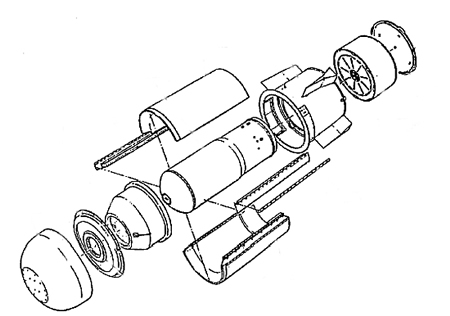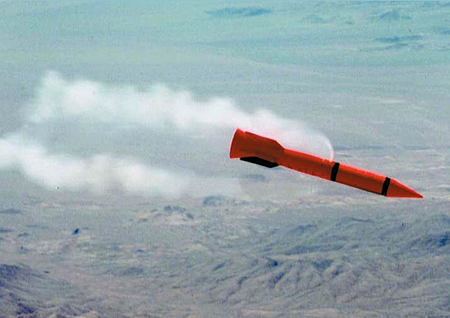 |
| The author next to a B53 shape outside the Atomic Museum in Albuquerque, NM. This open-air display is located at these coordinates: 35° 3’54.78″N, 106°32’7.09″W. |
.
By Hans M. Kristensen
The National Nuclear Surety Administration (NNSA) has announced that it has authorized the Pantex Plant in Texas to begin dismantlement of the B53 nuclear bomb.
Everything about the B53 is big: it weighs as much as a minivan and has an explosive yield of nine megatons, equivalent to 600 Hiroshima bombs.
Initially designed to annihilate Soviet cities, the large yield later earned the B53 one of the longest careers in the U.S. nuclear arsenal as a nuclear shovel; literally to dig up Soviet underground command bunkers. The mission was seen as so important that the B53 was even saved from an earlier retirement and allowed to serve for another decade until 1997 even though the Pentagon knew it had serious safety and security flaws.
Characteristics
The B53 is a two-stage thermonuclear bomb with a nuclear yield of nine megatons. At 148 inches (3.8 m) long and 50 inches (1.3 m) in diameter, the whole bomb weighs approximately 8,850 pounds (4 tons).
| “Exploded” B53 Bomb Components |
 |
| The behemoth B53 weighed as much as a minivan and had a yield of nine megatons. It’s mission was to destroy deeply buried facilities with enormous radioactive fallout as a consequence. Drawing obtained under the Freedom of Information Act. |
.
Approximately 340 B53s of two versions (Mod 0 and Mod 1) were produced between 1962 and 1965. The bomb weighs as much as a minivan and could only be delivered by the B-52 bomber, each of which could carry two of the behemoth weapons.
The B53 only had a laydown option and was timer armed and fired so the delivery bomber had time to get away before detonation.
The large yield could destroy facilities buried 750 feet (230 meters) underground.
History
The B53 was on continuous airborne alert onboard B-52 bombers between 1962 and 1968, when about a dozen bombers were kept in the air 24 hours a day loaded with fully ready nuclear weapons to ensure the Soviet Union couldn’t disarm the United States in a first strike. After the airborne alert was canceled, the B53 was on ground-alert until retirement first began in 1987.
But that retirement coincided with the retirement of the high-yield Titan II ICBM in June 1987, another nine-megaton weapon used to hold Soviet underground facilities at risk. So the Joint Chiefs of Staff in March 1987 directed Strategic Air Command to return B53s to B-52 bombers on alert:
“In order to hold selected deeply targets at risk in all scenarios, a day-to-day alert capability is required. The current capability will be lost when the last Titan II ICBM is deactivated on Jun [sic] 87. Therefore, a B53 ALFA Alert capability must be developed as soon as possible.”
One of these targets probably was the nuclear command and control center under Kosvinsky Mountain in central Russia.
The B53 stayed on alert until 1991, when the bomber ground alert was finally cancelled.
Unsafe but Important
The B53 was not built with modern safety features, although it was one-point safe (detonation of any one chemical high explosives would not produce a nuclear yield). And over its many years in the stockpile some basic safety design features were added to the weapon to enhance nuclear explosive safety, for example to prevent accidental electrical energy from lightning to trigger the weapon. But the B53 did not have Enhanced Nuclear Detonation Safety (ENDS), Insensitive High Explosive (IHE), Fire-Resistant Pit (FRP), Protective Action Link (PAL), or Command Disable (CD).
The government had known about safety issues in the B53 “for twenty years,” former Sandia Director Paul Robinson later stated. But holding a few high-priority Soviet underground targets at risk was considered so important that safety requirements were waived, allowing the B53 to remain in the stockpile.
Legislation passed by Congress in 1992 specified three modern safety features that should be incorporated into all U.S. nuclear warheads: ENDS; IHE; FRP. The nuclear weapons stockpile plan from early 1993 directed the retirement of all warheads that lacked ENDS.
So in July 1993, then DOE Deputy Assistant Secretary for Military Application (Defense Programs) Winford Ellis “strongly recommended” to Harold Smith, the Assistant to the Secretary of Defense (Atomic Energy), that the B53 bomb be retired “at the earliest possible date.” The weapon “has no assured level of nuclear safety in a broad range of multiple abnormal environments.”
In addition to safety issues, the B-52 bomber was no longer considered capable of penetrating the most advanced air defense systems, so U.S. Strategic Command wanted a modern nuclear bunker-buster capability on the B-2 stealth bomber.
| The B53 Replacement: The B61-11 |
 |
| The B-2 delivered B61-11 nuclear earth-penetrator (above, with spin motors in drop test) replaced the B-52 delivered B53 in 1997, improving the ability to penetrate modern air defenses and attack deeply buried facilities such as Russian command bunkers. |
.
The September 1994 NPR recommended replacing the B53 with a new bunker-buster, which eventually became the B61-11, a modified version of the B61-7 with earth-penetrating capability and increased yield. As the B61-11 entered the stockpile in 1997 on the B-2 bomber, the B53 was finally retired for the second time.
Only one other warhead, the W62 on the Minuteman III ICBM, had worse surety features than the B53. The W62 was allowed to remain in service until 2009.
That Good Old Nuclear Secrecy
Now, don’t hold your breath to be told how many B53s are being dismantled. After the Obama administration in May declassified the entire history of the size of the nuclear weapons stockpile as well as the number of warheads dismantled each year, mysterious national security now requires the government to keep secret the number of B53s to be dismantled at Pantex. Some things never change.
Excessive secrecy aside, the number of B53s to be dismantled is approximately 36.
This publication was made possible by a grant from Carnegie Corporation of New York and Ploughshares Fund. The statements made and views expressed are solely the responsibility of the author.
This report outlines a framework relying on “Cooperative Technical Means” for effective arms control verification based on remote sensing, avoiding on-site inspections but maintaining a level of transparency that allows for immediate detection of changes in nuclear posture or a significant build-up above agreed limits.
The grant comes from the Carnegie Corporation of New York (CCNY) to investigate, alongside The British American Security Information Council (BASIC), the associated impact on nuclear stability.
Satellite imagery of RAF Lakenheath reveals new construction of a security perimeter around ten protective aircraft shelters in the designated nuclear area, the latest measure in a series of upgrades as the base prepares for the ability to store U.S. nuclear weapons.
It will take consistent leadership and action to navigate the complex dangers in the region and to avoid what many analysts considered to be an increasingly possible outcome, a nuclear conflict in East Asia.